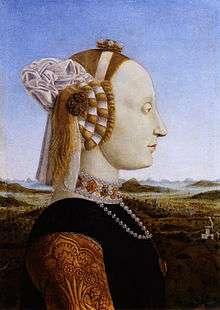Battista Sforza
| Battista Sforza | |
|---|---|
| Duchess of Urbino | |
|
Battista Sforza, by Piero della Francesca, c. 1465–70 | |
| Spouse(s) | Federico da Montefeltro |
|
Issue
Costanza? di Montefeltro (December 1460 – February 1461) Giovanna di Montefeltro (1462–1514) Isabetta di Montefeltro (c. 1464 – 1521) Costanza di Montefeltro (1466–1518) Violanta di Montefeltro Agnese di Montefeltro (1470–1522) Guidobaldo da Montefeltro (1472–1508) | |
| Noble family | Sforza |
| Father | Alessandro Sforza, Lord of Pesaro |
| Mother | Costanza da Ferano |
| Born |
1446 Pesaro |
| Died |
6 or 7 July 1472 (aged 25) Gubbio |
Battista Sforza (1446 – 6 or 7 July 1472) was the Duchess of Urbino and second wife of Federico da Montefeltro.
Biography
Battista was the first legitimate child born to Alessandro Sforza, lord of Pesaro, and Costanza da Varano (1428–1447), the eldest daughter of Piergentile Varano (d. 1433), Lord of Camerino, and Elisabetta Malatesta. In 1447, Costanza died after giving birth to her second child, a son called Costanzo (d. 1483), when Battista was 18 months old. After the death of their mother Battista and Costanzo, together with their illegitimate half-sisters Ginevra (1440–1507) and Antonia (1445–1500), moved to the court of their paternal uncle Francesco Sforza and his wife Bianca Maria Visconti where they were brought up alongside their cousins.[1]
Battista and her cousin Ippolita Maria received a humanist education and the former was fluent in Greek and Latin, giving her first Latin public speech at the age of four.[2] She was said to be very skilled in Latin rhetoric and even gave an oration before Pope Pius II. The poet Giovanni Santi described Battista as "a maiden with every grace and virtue rare endowed".[3]
Her uncle Francesco Sforza arranged for her marriage to Federico da Montefeltro, Duke of Urbino, who was twenty-four years older than her. The wedding took place on 8 February 1460, when Battista was fourteen years old, and she acted as regent during her husband's absences from Urbino.[4][5] Their marriage was a happy one and they were described by a contemporary, Baldi, as "two souls in one body".[1] Federico called Battista "the delight of both my public and my private hours."[6] Moreover, he spoke with her about political issues and she accompanied him to almost all official events outside of Urbino.
Carrying on the Sforza family's tradition of humanist education for women, she educated her daughters similarly to the education she had received from her aunt Bianca Maria. Similarly, Battista's granddaughter Vittoria Colonna, daughter of Agnese, was a famous poet.
After giving birth to six daughters, Battista gave birth to their first son and heir Guidobaldo da Montefeltro on 24 January 1472.[1] However, three months after the birth of their son, Battista, having never fully recovered from her last pregnancy and labour, fell ill and died in July 1472.
References
- 1 2 3 Vogt-Lüerssen, Maike, 'Battista Sforza, Duchess of Urbino,'
- ↑ Robin, Diana Maury; Anne R. Larsen, Carole Levin (2007). Encyclopedia of Women in the Renaissance: Italy, France, and England. ABC-CLIO. p. 119. ISBN 978-1-85109-772-2.
- ↑ Osborne, June (2003). Urbino: the story of a Renaissance city. Frances Lincoln Ltd. p. 66. ISBN 978-0-7112-2086-7.
- ↑ Gardner, H., & Kleiner, F. S. (2017). Gardner's Art Through the Ages: A Concise Global History, Cengage, p. 245.
- ↑ Tinagli, Paola (1997). Women in Italian Renaissance art: gender, representation, identity. Manchester University Press. p. 58. ISBN 978-0-7190-4054-2.
- ↑ Spielvogel, Jackson J. (2011). Western Civilization: Since 1300. Cengage Learning. p. 349. ISBN 978-1-111-34219-7.
Further reading
- Millington, Ellen J. (1865), Charlotte Mary Yonge, ed., Biographies of Good Women, London: J. and C. Mozley, pp. 1–35
External links
- The Gubbio Studiolo and its conservation, volumes 1 & 2, from The Metropolitan Museum of Art Libraries (fully available online as PDF), which contains material on Battista Sforza (see index)
